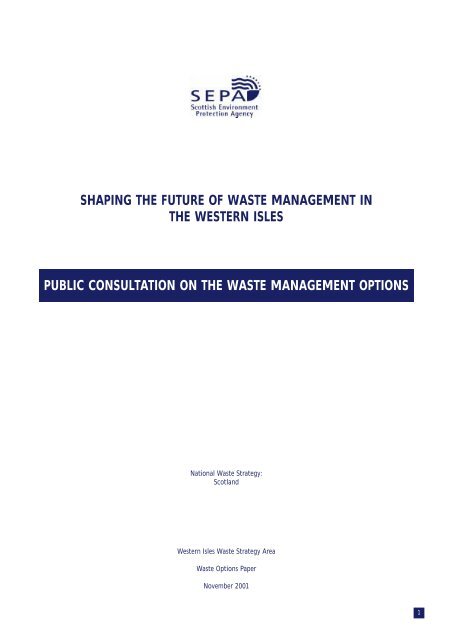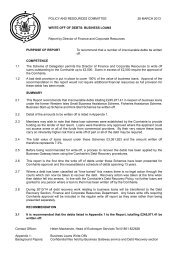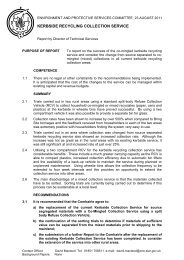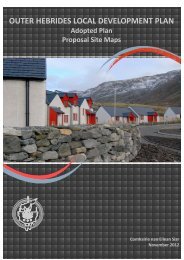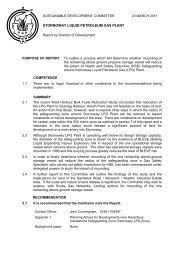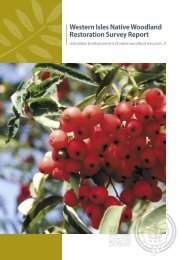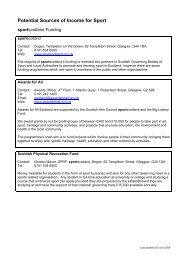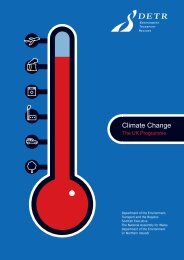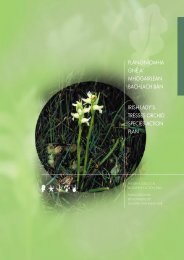Waste Management Strategy - Comhairle nan Eilean Siar
Waste Management Strategy - Comhairle nan Eilean Siar
Waste Management Strategy - Comhairle nan Eilean Siar
Create successful ePaper yourself
Turn your PDF publications into a flip-book with our unique Google optimized e-Paper software.
SHAPING THE FUTURE OF WASTE MANAGEMENT IN<br />
THE WESTERN ISLES<br />
PUBLIC CONSULTATION ON THE WASTE MANAGEMENT OPTIONS<br />
National <strong>Waste</strong> <strong>Strategy</strong>:<br />
Scotland<br />
Western Isles <strong>Waste</strong> <strong>Strategy</strong> Area<br />
<strong>Waste</strong> Options Paper<br />
November 2001<br />
1
Contents<br />
Foreword 3<br />
1 Introduction 4<br />
2 Reason for Change: New Legislation 4<br />
3 Baseline Data 5<br />
3.1 Area Background 5<br />
3.2 <strong>Waste</strong> Data 5<br />
3.3 Changes Required to Achieve the Landfill Directive 6<br />
4 <strong>Waste</strong> <strong>Management</strong> Options Background 7<br />
4.1 Best Practicable Environmental Option (BPEO) 7<br />
4.2 The <strong>Waste</strong> Hierarchy 8<br />
5 What are the Options 9<br />
5.1 <strong>Waste</strong> Minimisation 10<br />
5.2 Recycling and Re-use Initiatives 11<br />
5.3 Option 1: Landfill 12<br />
5.4 Option 2: Incineration 12<br />
5.5 Option 3: Centralised In-Vessel Composting 13<br />
5.6 Option 4: Centralised Anaerobic Digestion 14<br />
5.7 Option 5: Export 15<br />
6 Next Stage 15<br />
Annex<br />
Key <strong>Waste</strong> <strong>Management</strong> Principles 16<br />
A Useful Guide to <strong>Waste</strong> 16<br />
2<br />
Western Isles <strong>Waste</strong> Options Paper
Foreword<br />
The National <strong>Waste</strong> <strong>Strategy</strong>: Scotland was published by the Scottish Environment Protection Agency (SEPA) and endorsed by<br />
the Scottish Executive Ministers in December 1999.<br />
The <strong>Strategy</strong> is a framework document, which facilitates strategic decisions from key waste management players through the<br />
setting up of Area <strong>Waste</strong> Groups and the development of Area <strong>Waste</strong> Plans. Eleven waste planning areas, one of which is the<br />
Western Isles, are defined in the strategy,.<br />
An Area <strong>Waste</strong> Group was set up in July 2000 to develop a plan for the Western Isles. The group consists of a number of<br />
stakeholders from the local, private and voluntary sectors and includes representation from the community.<br />
The Area <strong>Waste</strong> Plan will seek to address the main issues affecting waste management in the Western Isles and propose<br />
solutions. It is recognised that the final plan will have to be continually reviewed and developed as local circumstances change,<br />
new technology is developed and new legislation is introduced.<br />
This paper introduces the process and the issues as well as presenting possible solutions for an integrated waste management<br />
strategy for the Western Isles over the next 20 years. Its purpose is to stimulate interest and discussion among the public. Your<br />
views will be taken into consideration as the plan develops.<br />
We would urge you to take this opportunity to have your say and complete the questionnaire included with this document.<br />
Tom Anderson<br />
Area <strong>Waste</strong> Group Chair<br />
Angus Nicolson<br />
Councillor<br />
The Western Isles Area <strong>Waste</strong> Group includes representatives from:<br />
• Chamber of Commerce<br />
• Stornoway Amenity Group<br />
• <strong>Comhairle</strong> <strong>nan</strong> <strong>Eilean</strong> <strong>Siar</strong><br />
• Stornoway Trust<br />
• Crofters Union • Uist 2000<br />
• Denis Autos<br />
• Western Isles Aquaculture Working Group<br />
• Highlands and Islands Enterprise<br />
• Western Isles Enterprise and other LECs<br />
• Lews Castle College, UHI<br />
• Western Isles Fishermen Association<br />
• North of Scotland Water Authority (NoSWA)<br />
• Western Isles Health Board<br />
• Scottish Environment Protection Agency (SEPA)<br />
• Western Isles Seafood Company<br />
• Scottish Natural Heritage<br />
Western Isles <strong>Waste</strong> Options Paper 3
1 Introduction<br />
Area <strong>Waste</strong> Plans are the mechanism identified in the National <strong>Waste</strong> <strong>Strategy</strong>: Scotland to ensure that the objectives and<br />
policies of the <strong>Strategy</strong> are achieved and that both local and regional issues can be accounted for in the development of an<br />
integrated waste strategy for Scotland.<br />
The objective of each plan is to provide a local framework document that will facilitate strategic planning of the integrated<br />
network of facilities needed to manage waste in the future. There are four key steps in this process:<br />
• determining the baseline: This process involves gathering information on what happens to Western Isles waste at present and<br />
determining what changes in waste production and composition are likely over the next 20 years<br />
• considering options for the future: The Area <strong>Waste</strong> Group has determined five possible options for Western Isles waste by<br />
2020. We are now consulting the public for their views<br />
• identification of the Best Practicable Environmental Option (BPEO): This takes public comment into consideration and, after<br />
further analysis, the options are narrowed down<br />
• Area <strong>Waste</strong> Plan preparation: The Area <strong>Waste</strong> Plan is produced with further public consultation.<br />
There are a number of key issues that will shape the future of how waste will be managed in the Western Isles. The Area <strong>Waste</strong><br />
Group has drawn up a shortlist of options for waste management in the area. An important part of the process is to ensure that<br />
these issues are discussed and considered by a wider audience and therefore this consultation document seeks your views.<br />
2 Reason for Change: New Legislation<br />
There is an increasing amount of legislation governing waste management, with an emphasis on improving environmental<br />
standards and pushing waste management towards more sustainable methods of treatment.<br />
The impact of European Directives is increasingly influencing the way in which waste management is approached. The most<br />
significant of the new Directives is the Landfill Directive which seeks to impose minimum environmental standards for landfills<br />
across Europe.<br />
The Directive is particularly important in that it requires a progressive reduction in the landfilling of Biodegradable Municipal<br />
<strong>Waste</strong> (BMW), such as food, paper and wood which when landfilled decompose and produce pollutants.<br />
The Directive sets stringent standards so that the amount of BMW going to landfill must decrease by 25% by 2010, 50% by<br />
2013 and 65% by 2020. This is compared to 1995 values which act as the baseline.<br />
The Directive will also affect the type of materials that can be routinely accepted at landfills. For example, bans on liquid waste<br />
and tyres going to landfill sites will come into effect sometime between 2002 and 2007.<br />
4<br />
Western Isles <strong>Waste</strong> Options Paper
3 Baseline Data<br />
The baseline data tells us:<br />
• the current situation regarding waste production and management<br />
• the probable future situation regarding waste production<br />
• what changes will have to be made to ensure that the Landfill Directive requirements for BMW disposal are met.<br />
3.1 Area Background<br />
The first part of the development of an Area <strong>Waste</strong> Plan is to establish the current position in terms of waste disposal and<br />
estimate probable future requirements.<br />
The population of the Western Isles was estimated by Highlands and Islands Enterprise as 28,000 in 1997, compared with 29,500<br />
in 1991. This decrease is projected to continue over the next ten years.<br />
The main industry is fishing (sea fishing, fish farming and fish processing) although education and transport-related activities<br />
are also relatively important. In contrast, general manufacturing activity, agriculture and food and drink processing are all less<br />
important than in Scotland as a whole.<br />
As the Western Isles are self-contained in relation to waste disposal, the level of consumption relates directly to population and<br />
economic activity within the islands. The Area <strong>Waste</strong> Group has therefore assessed that there will be only a small increase in<br />
waste production over the next 20 years.<br />
3.2 <strong>Waste</strong> Data<br />
The Western Isles disposes around 28,000 tonnes of household, commercial and industrial waste to landfill each year.<br />
Approximately 80% of this is collected at Bennadrove landfill site near Stornoway. In addition, up to 1,000 tonnes of other<br />
wastes, such as scrap metal, clinical waste and other special wastes are collected annually and shipped to the mainland for<br />
reprocessing or safe disposal.<br />
Collection and transportation costs in some parts of the islands are greater than virtually anywhere else in the UK. For example,<br />
it costs in the region of £50,000 each year to transport 1,000 tonnes of household and commercial waste produced in Barra to<br />
the nearest disposal and treatment facility in Benbecula. Other than relatively localised private skip hire companies there is a<br />
lack of private sector involvement in waste collection.<br />
Information on the production and disposal of inert construction and demolition waste is less well known. During the year<br />
2000, 1,200 tonnes of inert waste were deposited at private landfill sites and it is estimated that a similar quantity was re-used<br />
for roads, building foundations etc. Total annual production is therefore in the range of 2,500 tonnes.<br />
Although the amount of waste per household is increasing, the decline in population in the Western Isles should result in no<br />
significant increase in waste arising per year in the foreseeable future. All options presented in this document are therefore<br />
based on a total waste production by the islands of 30,000 tonnes per year by 2020.<br />
Western Isles <strong>Waste</strong> Options Paper 5
3.3 Changes Required to Achieve the Landfill Directive<br />
Like all other <strong>Waste</strong> <strong>Strategy</strong> Areas the Western Isles must decrease the amount of biodegradable municipal waste (BMW) going<br />
to landfill.<br />
This will mean that the Western Isles will only be able to landfill approximately 7,500 tonnes of BMW in 2010, 5,000 in 2013<br />
and 3,500 in 2020. This compares with approximately 10,000 tonnes of BMW which was landfilled in 1995.<br />
Figure 1: Tonnes of biological municipal waste that can be landfilled of under the Landfill Directive<br />
%<br />
year<br />
6<br />
Western Isles <strong>Waste</strong> Options Paper
4 <strong>Waste</strong> <strong>Management</strong> Options Background<br />
This section provides information on how the options presented in this paper were assessed by the Area <strong>Waste</strong> Group.<br />
4.1 Best Practicable Environmental Option (BPEO)<br />
The Best Practicable Environmental Option (BPEO) is the option that provides the most benefits, or least damage, to the<br />
environment as a whole at acceptable cost, in the long term as well as in the short term. The local Area <strong>Waste</strong> Group will apply<br />
this philosophy to the drafting of the Area <strong>Waste</strong> Plan for the Western Isles. All the options were appraised by the group on the<br />
following criteria:<br />
• Environmental What are the environmental implications for the Western Isles (e.g. effects on air, land, water, natural and<br />
cultural heritage, global warming, local amenity, non-renewable resource use, accidental risks).<br />
• Economic What are the economic implications in the Western Isles Does the option bring money into the Western Isles<br />
by new markets and commercial opportunities. This will include savings from recycling and resource re-use and recycling.<br />
(e.g. cost, affordability, impact on local economy, employment opportunities).<br />
• Social Implications for the population of the Western Isles in terms of jobs and the provision of opportunities to develop<br />
local skills and opportunities for future development. Will the option and its implementation achieve the aspirations of the<br />
local communities (e.g. employment, public acceptability, skills, making people responsible for the wastes they produce).<br />
• Practicability Would the option work in the Western Isles (e.g. technical feasibility, making use of existing facilities,<br />
flexibility).<br />
• Compliance with other policies Does the proposed option fall in line with national and European legislation and local<br />
policies (e.g. Landfill Directive, renewable energy policy).<br />
SEPA has provided guidance to all Area <strong>Waste</strong> Groups on how the BPEO should apply to developing an Area <strong>Waste</strong> Plan. This<br />
guidance was adopted in the Western Isles to develop the issues and options to be considered for the future. However a more<br />
intuitive approach was applied to the process when the standard model did not provide accurate information due to the<br />
relatively small volumes of waste being produced.<br />
Western Isles <strong>Waste</strong> Options Paper 7
4.2 The <strong>Waste</strong> Hierarchy<br />
The waste hierarchy provides a framework within which the most desirable waste management options are set out.<br />
The simple premise of the hierarchy is the promotion of effective management of the resource currently regarded as waste by<br />
reducing the waste produced in the first place. Re-use involves items being used again for the same or a different purpose.<br />
Value should be gained from the waste through recycling, composting or energy recovery through is incineration or other<br />
technologies. The end option is the disposal of materials no longer of value or useful purpose.<br />
Figure 2: The <strong>Waste</strong> Hierarchy<br />
Reduce<br />
Re-use<br />
Recycle and Compost<br />
Recover Energy<br />
Disposal<br />
This framework has also been used by the group to help appraise the options for waste management in the Western Isles.<br />
A number of other key concepts are summarised in the Annex.<br />
8<br />
Western Isles <strong>Waste</strong> Options Paper
5 What are the Options<br />
The Area <strong>Waste</strong> Group has determined five options for the structure of waste management in the Western Isles for 2020.<br />
Table 1: Options for Western Isles <strong>Waste</strong> by 2020.<br />
OPTION 1 OPTION 2 OPTION 3 OPTION 4 OPTION 5<br />
Minimisation Minimisation and new Minimisation and Minimisation and Minimisation<br />
and Landfill Energy from centralised In-Vessel centralised In-Vessel and Export<br />
<strong>Waste</strong> Plant Composting Anaerobic Digestion<br />
<strong>Waste</strong> <strong>Waste</strong> <strong>Waste</strong> <strong>Waste</strong> <strong>Waste</strong><br />
Minimisation Minimisation Minimisation Minimisation Minimisation<br />
Encourage Encourage Encourage Encourage Encourage<br />
local local local local local<br />
initiatives initiatives initiatives initiatives initiatives<br />
Recycling and Recycling and Recycling and Recycling and Recycling and<br />
Reprocessing Reprocessing Reprocessing Reprocessing Reprocessing<br />
Increased recycling of Increased recycling of In-vessel composting of Anaerobic digestion of Increased<br />
glass, paper, plastics glass, paper, plastics all biodegradable waste all biodegradable waste recycling of<br />
and metals. and metals. at central facility in at central facility in glass, paper,<br />
Stornoway. Stornoway. plastics and<br />
metals<br />
Increased recycling of<br />
glass, paper, plastics<br />
and metals.<br />
Increased recycling of<br />
glass, paper, plastics<br />
and metals.<br />
Recovery Recovery Recovery Recovery Recovery<br />
None Energy produced Soil improver Energy produced None<br />
Liquid fertiliser<br />
Soil improver<br />
Disposal Disposal Disposal Disposal Disposal<br />
Existing waste Reduced quantities Significantly less waste Significantly less waste No disposal<br />
quantities to landfill to landfill (ash) to landfill to landfill in <strong>Strategy</strong><br />
Area<br />
Capital Costs Capital Costs Capital Costs Capital Costs Capital Costs<br />
£4 - 6 million* £7 - 10 million* £4 - 6 million* £4 - 6 million* £2 - 3 million*<br />
Council Funded Likely to be grant assisted Likely to be grant assisted Likely to be grant assisted Council Funded<br />
Disposal Cost Disposal Cost Disposal Cost Disposal Cost Disposal Cost<br />
per tonne per tonne per tonne per tonne per tonne<br />
£70 - £80 £50 - £80 £30 - £40 £30 - £40 £100 - £120<br />
* Costing are estimates only and are currently being investigated.<br />
Western Isles <strong>Waste</strong> Options Paper 9
All options take into consideration the high transportation costs in the islands (this can be in the order of £65 to £85 per<br />
tonnes, compared with an average in the UK of between £20 to £40 per tonne). Transportation of waste in the islands is such a<br />
major factor in the waste strategy that all efforts will be made to reduce the environmental dis-benefit that it inevitably will<br />
lead to.<br />
It is the Area <strong>Waste</strong> Group’s opinion that serious consideration must be given to the development of sea transportation as an<br />
alternative to road transportation. Such a development should lead to lower costs, both inter-island and mainland, and<br />
consequently benefit the viability of local business.<br />
When looking at future solutions for dealing with waste, the most sustainable projects may be those that involve working in<br />
partnership with other areas and groups. There is scope within the Western Isles Area <strong>Waste</strong> Plan to consider working closely<br />
with the Highland Area to process waste arisings from the Isle of Skye and potentially from other areas on the north west coast<br />
of Scotland. This could assist both <strong>Waste</strong> <strong>Strategy</strong> Areas to arrive at a waste solution which is globally more beneficial to the<br />
environment and offers higher diversion rates from landfill than would otherwise be possible.<br />
5.1 <strong>Waste</strong> Minimisation (included in all options)<br />
The best way to deal with the consequences of waste is simply to reduce its production in the first place. The group therefore<br />
believes that waste minimisation is a fundamental part of all future options for the Western Isles. Its importance has<br />
been recognised in the National <strong>Waste</strong> <strong>Strategy</strong>: Scotland which states:<br />
“Reduction in the generation of waste and use of natural resources is often the most effective environmental option”.<br />
Although there are no formal waste minimisation schemes in the Western Isles the communities have traditionally been able to<br />
prolong the use of resources.<br />
Education and organised activities would raise awareness of the opportunities and innovations in waste management to<br />
potentially decrease the amount of wastes landfilled and make economic and environmental savings. The commercial and<br />
industrial sector in particular have good economic reasons for encouraging waste minimisation as it can:<br />
• reduce consumption of energy and raw materials<br />
• reduce disposal needs<br />
• lead to potential job opportunities.<br />
<strong>Waste</strong> minimisation initiatives could be funded through the <strong>Waste</strong> Awareness Scotland (WAS) programme aimed at promoting<br />
waste minimisation in Scottish communities. In addition, the Local Enterprise Network also has funding for the promotion of<br />
waste minimisation initiatives and Best Practice in business and industry.<br />
One of the options open to the Western Isles is to employ a waste minimisation and recycling officer to assist communities<br />
and industry with minimisation issues.<br />
10<br />
Western Isles <strong>Waste</strong> Options Paper
5.2 Recycling and Re-use Initiatives (included in all options)<br />
There are many re-use and recycling initiatives already in the Western Isles. All waste options will include the promotion of<br />
current initiatives and stimulation of ideas and business opportunities. Specific attention will be paid to wastes which can easily<br />
be processed and re-used locally.<br />
Local Authority<br />
Recycling has been revived recently as a result of the Local Authority<br />
implementing several recycling and reprocessing schemes. These schemes are<br />
at an early stage of development and concentrate in the Stornoway area, with<br />
a planned expansion in the service programmed over the next one to two years.<br />
The following types of waste are currently recycled:<br />
• drinks cans - aluminium and steel cans are collected, baled and sent to<br />
the Scottish mainland for reprocessing when economically viable volumes<br />
have accumulated<br />
• plastic bottles - collected bottles are also crushed, baled and sent to the Scottish mainland for reprocessing when<br />
economically viable volumes have accumulated<br />
• paper - newsprint is collected at Bennadrove. It is shredded and baled locally and used as animal bedding<br />
• gass - non-segregated glass is collected and crushed locally for use as an aggregate replacement in drainage projects and<br />
other similar applications<br />
• scrap cars - these are collected under contract, baled and exported for re-processing<br />
• reclaimed wood - unwanted furniture and wood is collected at Bennadrove for re-use locally<br />
• oil - transported to Bennadrove landfill site for de-watering, bulking into economically viable loads and export for<br />
re-processing<br />
• tyres - a recent visit by a tyre baler to Benbecula has proved very successful. The bales will be used locally in landfill<br />
construction work.<br />
Community Initiatives<br />
Voluntary and community re-use and recycle initiatives divert a substantial amount<br />
of unwanted goods from other disposal routes. Community councils are particularly<br />
active with such initiatives. Other community groups and organisations such as<br />
Voluntary Action Barra, Proiseact Uibhist 2000, Iomairt aig an Oir, the Stornoway<br />
Amenity Trust and local common grazings committees could also become involved<br />
in this area. Many of these initiatives receive assistance from the Council.<br />
Examples of such activities include:<br />
• local events such as jumble and car boot sales, and the Western Isles Beach Clean<br />
• demolition stone - a number of projects have re-used local demolition stone in<br />
community buildings and walls<br />
• textiles - these are collected by Blythswood who use any useful items and<br />
transport rags to the mainland for reprocessing.<br />
The group believes that the promotion of all economically viable recycling and re-use initiatives should be included in all<br />
waste options for the Western isles.<br />
Western Isles <strong>Waste</strong> Options Paper 11
5.3 Option 1: Landfill (No change)<br />
Apart from waste minimisation and recycling initiatives the Western Isles would continue to rely on landfill to dispose of all its<br />
wastes. Refuse collection vehicles (RCVs) would transport all wastes to Bennadrove for landfilling.<br />
An extension to the main landfill site at Bennadrove would be required in approximately 8 to 10 years. This would cost in the<br />
region of £4 to 6 million to construct due to the new legislative requirements. It is unlikely that any external grant funding<br />
would be available to contribute to the cost.<br />
BPEO Considerations<br />
• Environmental Poor use of re-usable and recyclable materials. No energy recovery. Difficult to control emissions to both<br />
air and water. New cells would be engineered to a higher environmental standard under the Landfill Directive. All emissions<br />
would require to be controlled.<br />
• Economic The current landfill tax levy of £2 per tonne for inert material and £12 per tonne for non-inert materials result<br />
in a total estimated annual bill of £340,000. Landfill tax rises in the future could potentially increase this to £750,000<br />
annually. In addition, landfill permits would have to be bought from 2010 onwards to ensure that the Landfill Directive was<br />
met. These are estimated to cost £60 per tonnes, however, market demands may result in significant higher prices.<br />
• Social This system is already in operation and therefore there are unlikely to be further employment or skill opportunities.<br />
Very little personal responsibility for your own waste.<br />
• Practicability All infrastructure is already in place. Once Rueval is full waste transfer stations will need to be constructed<br />
to bulk up waste for transportation and disposal at Bennadrove.<br />
• Compliance with other Policies Very poor. Although waste minimisation and local recycling initiatives will reduce the<br />
amount of organic wastes being landfilled it is estimated that this will not be enough to reach the Landfill Directive targets<br />
for BMW. Landfill permits must be purchased from other waste areas to allow levels of landfilling to continue.<br />
What about Rueval<br />
Rueval landfill site is estimated to meet full capacity by 2006 and all wastes will need to be transported to the<br />
Bannadrove landfill site for disposal from then on.<br />
What’s a landfill permit<br />
Any <strong>Waste</strong> Area that surpasses its Landfill Directive targets for BMW can sell on its ‘credit to other <strong>Waste</strong> Areas<br />
who have not managed to decrease their waste to the same extent.<br />
The costs of these credits, called landfill permits, is decided on by market demand and is currently estimated as £60<br />
per tonne. However, if in demand prices could be much higher.<br />
5.4 Option 2: Incineration<br />
In addition to waste minimisation initiatives a new Energy from <strong>Waste</strong> plant would be built near Stornoway. Non-segregated<br />
wastes would be collected from all islands and transported to Stornoway for disposal.<br />
A partnership with the Highland Area whereby waste from Skye and the north west fringes of mainland Scotland were imported<br />
to the incinerator would ensure that sufficient waste is gathered to run the system successfully.<br />
The energy produced would be used either to generate electricity or for a district heating system.<br />
Bottom ash would be disposed of at Bennadrove and fly ash would be transported to mainland Scotland for safe disposal.<br />
12<br />
Western Isles <strong>Waste</strong> Options Paper
BPEO Considerations<br />
• Environmental Possible reduction in transportation costs and amount of material going to landfill. All emissions would be<br />
controlled. Some energy recovery, therefore, lowering the requirement for other energy sources.<br />
• Economic Substantial start up cost. Unit costs are relatively high in comparison to landfill, however this difference will<br />
reduce as the cost for landfill rises. Potential to sell landfill permits to other waste areas. Income from accepting wastes<br />
from other areas.<br />
• Social Would result in significant employment. New skills required. Producers not responsible for their own waste. Would<br />
have to be located to ensure odour, traffic, litter and noise do not cause a public nuisance. May adversely affect local house<br />
prices.<br />
• Practicability High planning risk as option is not flexible to changing circumstances. Volumes and types of waste would<br />
have to be consistent. Would rely heavily on wastes from outwith waste strategy area to ensure viability. <strong>Waste</strong> transport<br />
may be affected by weather.<br />
• Compliance with other Policies The plant would require an Integrated Pollution Control (IPC) Authorisation. All Landfill<br />
Directive targets would be met.<br />
5.5 Option 3: Centralised In-Vessel Composting<br />
In addition to waste minimisation initiatives the recycling of the organic fraction of waste (such as vegetable peelings and<br />
garden wastes) will be increased. This option relies on a large centralised composting plant in Stornoway taking biodegradable<br />
waste from all the islands. All areas would be required to segregate their vegetable and garden wastes and either deliver them<br />
to a local bring site or present them for collection by a split RCV. Recyclable materials such as glass, paper, plastics and metals<br />
would also be collected at these bring sites. All other wastes would be collected and transported to Bennadrove landfill site for<br />
disposal.<br />
A soil conditioner material would be produced and used, if possible, for land improvement schemes. If not it would be<br />
transported to Bennadrove to be used for landscaping.<br />
As in option 2 waste would also be imported from Skye and the western fringes of the mainland. These and other segregated<br />
wastes that could be used in the Western Isles would be transported by sea. This form of transportation could also be used to<br />
transfer waste from the southern isles to Stornoway.<br />
BPEO Considerations<br />
• Environmental All emissions from the composting vessel would be controlled. No energy recovery. Additional<br />
transportation from Skye and Scottish mainland would be involved.<br />
• Economic Split RCVs would need to be bought. Income could be generated from accepting wastes from other waste areas.<br />
Potential to sell landfill permits to other waste areas.<br />
• Social Some personal responsibility for your own waste. Some new skills required. Recycling access improved in some<br />
islands. Potential additional employment in plant and relating to shipping.<br />
• Practicability Technology well proven. <strong>Waste</strong> transport may be affected by weather.<br />
• Compliance with other Policies Fit Good participation would result in Landfill Targets being met.<br />
What’s a split RVC<br />
This is a bin lorry with separate compartments to take different segregated wastes such as cans, glass and vegetable and<br />
garden waste<br />
Western Isles <strong>Waste</strong> Options Paper 13
What is composting<br />
Composting is the biological process in which micrco-organisms convert degradable organic matter into carbon dioxide and<br />
water vapour using oxygen in the air and leaving a stabilised residue known as compost.<br />
And in-vessel composting<br />
With in-vessel composting the process happens inside a sealed container and computerised controls optimise levels of<br />
moisture, air temperature and mixing. Emissions are controlled and the time required for composting is less than with<br />
traditional pit style systems. The end product is also usually of a higher quality and is therefore more useful.<br />
5.6 Option 4: Centralised Anaerobic Digestion<br />
This option is an extension to Option 3. An anaerobic digestion plant in Stornoway would use the organic fraction of the waste<br />
to produce methane that would then generate electricity. As with option 3 all areas would either have a weekly collection by a<br />
split RCV or access to a bring site. Recyclable materials such as glass, paper, plastics and metals will once again be collected<br />
separately with all other non-biodegradable wastes being transported for landfilling at Bennadrove.<br />
If some form of pasteurisation system could be added to the plant aquaculture wastes could also be processed.<br />
BPEO Considerations<br />
• Environmental All emissions are controlled. Energy recovery. Potential for long-term land improvement scheme. Some<br />
additional transportation required.<br />
• Economic Split RCVs would need to be purchased. Additional income from accepting aquaculture waste from throughout<br />
Scotland and from accepting some wastes from western mainland. Potential to sell landfill permits. Saving in energy costs<br />
due to electricity production.<br />
• Social Producers held responsible for their waste. New skills required. Recycling improved in some islands. Definite<br />
potential for employment in plant and shipping.<br />
• Practicability Technology not proven for municipal waste in the UK although well proven on the Continent. Flexible to<br />
changing circumstances.<br />
• Compliance with other Policies All biodegradable municipal waste disposed of in this manner, therefore all landfill<br />
targets met.<br />
What is anaerobic digestion<br />
Anaerobic digestion is a biological process in which micro-organisms convert degraded organic matter into carbon dioxide,<br />
methane, water, heat in the absence of oxygen, and leaves a residue known as digestive which can be used as a soil<br />
conditioner. Liquid fertiliser is also produced. The methane is collected and used as a fuel and there is the potential for local<br />
heat use.<br />
14<br />
Western Isles <strong>Waste</strong> Options Paper
5.7 Option 5: Export<br />
Non-segregated wastes would be collected and transported from the Western Isles by ship to mainland Scotland for disposal.<br />
BPEO Considerations<br />
• Environmental Does not fit with the Proximity Principle which suggests that wastes should be treated or disposed of as<br />
close to where they arise as possible to reduce transportation. Higher risk of accident due to greater transportation. No<br />
energy recovery.<br />
• Economic Potentially very expensive as there is no real control over final disposal cost. Very much at the mercy of market<br />
forces. Additional transfer facility required to bulk wastes before shipment.<br />
• Social Unlikely to be additional skills or employment within the Western Isles. Any additional employment is likely to be<br />
elsewhere.<br />
• Practicability Low planning risk. Collection may be affected by weather. Current waste management facilities not used.<br />
• Compliance with other Policies Does not help to reduce disposal of biodegradable municipal waste nationally.<br />
6 Next Stage<br />
Comments are welcomed on any aspect of waste management in the Western Isles. The Area <strong>Waste</strong> Group is, however,<br />
particularly keen to seek views on the options presented. A questionnaire sheet has been produced to help you with<br />
this process.<br />
The consultation process runs until 21 December 2001. Feedback from the consultation will be used to come to a final decision<br />
on the options for the Western Isles and will shape the production of the draft and final plans. Everybody will have<br />
the opportunity to comment on the draft plan early next year.<br />
Responses should be returned to:<br />
Scottish Environment Protection Agency<br />
FREEPOST IV342<br />
Graesser House<br />
Fodderty Way<br />
Dingwall<br />
IV15 9BR<br />
email: westernisleswaste@sepa.org.uk<br />
telephone: 01349 860367<br />
Western Isles <strong>Waste</strong> Options Paper 15
Annex<br />
Key <strong>Waste</strong> <strong>Management</strong> Principles<br />
The Proximity Principle and Self Sufficiency<br />
The proximity principle means that waste should be treated or disposed of as near as possible to the point where it<br />
arises. Communities should understand that the waste they produce is a problem with which they must deal. Local<br />
Authorities (as planning authorities) and businesses should consider the proximity principle when they consider the<br />
requirements for, and location of, waste management facilities. The principle aims to avoid the adverse environmental<br />
impact of unnecessary transport.<br />
However, the environmental impact of transporting wastes depends on the mode of transport adopted. For example, a<br />
longer journey by river or rail may be environmentally preferable to a shorter road journey.<br />
The application to the principle will therefore vary according to the waste concerned, the volume and the potential<br />
environmental impact of the method of waste disposal and mode of transport. There also has to be a balance between<br />
the proximity principle and economies of scale. In some cases, economies of scale may mean that some specialist<br />
recovery or disposal operations may be located far from the point where the waste arises.<br />
The overall aim of the proximity principle is to move as far as possible towards self-sufficiency in waste management<br />
by the UK as a Member State within Europe, by Scotland within the UK and by local areas within Scotland.<br />
The Precautionary Principle<br />
The precautionary principle was defined by the UN Conference on Environment and Development, in the Rio<br />
Declaration as “where there are threats of serious or irreversible damage, lack of full scientific certainty shall not be<br />
used as a reason for postponing cost-effective measures to prevent environmental degradation”. The principle involves<br />
taking precautions now to avoid possible environmental damage or harm to human health in the future, even<br />
although the scientific basis for taking the precautions may be inconclusive.<br />
A Useful Guide to <strong>Waste</strong><br />
Anaerobic digestion<br />
Biodegradable Municipal<br />
<strong>Waste</strong>s (BMW)<br />
Bottom ash<br />
Bring sites<br />
Centralised composting<br />
Civic amenity sites<br />
Commercial wastes<br />
Community composting<br />
Composting<br />
Biological degradation of organic waste in the absence of oxygen in a sealed vessel at<br />
temperatures of 30-60ºC, to give methane gas (used as a fuel) and digestate (which can<br />
be composted and used as a soil conditioner).<br />
That portion of municipal waste which biodegrades - eg kitchen scraps, paper and garden<br />
wastes. Approximately 60% of all municipal waste.<br />
Ash which falls through the grate. Generally classed as inert and landfilled or in some<br />
places used in construction. Typically 30% of waste input.<br />
Local sites with large banks for you to bring your recyclable waste to.<br />
Composting at a large scale, where waste from a wide area is brought to one place.<br />
Local sites accepting waste which cannot be taken by RCVs. Most have recycling banks.<br />
<strong>Waste</strong>s from non-domestic and non-industrial premises (offices, shops, restaurants etc).<br />
<strong>Waste</strong> from a village / street is composted together - usually a voluntary initiative.<br />
Biological degradation of organic waste in the presence of oxygen, to a point where it is<br />
stabilised. Anything which once was alive can be composted.<br />
16<br />
Western Isles <strong>Waste</strong> Options Paper


